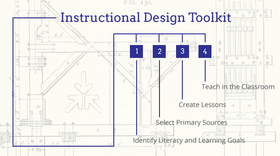Primary Source Exemplar: The Moon
Learning Objectives
Students will be able to:
Use pictures, numbers and/or words to solve problems about the moon using the primary source- NY Times article "First Man on Moon"
Use math manipulatives or faux moon rocks to represent the rocks noted in the equations
Standards Addressed
Math CCSS 1.OA Operations & Algebraic Thinking
Represent and solve problems involving addition and subtraction. Use addition and subtraction within 20 to solve word problems involving situations of adding to, taking from, putting together, taking apart, and comparing, with unknowns in all positions, e.g., by using objects, drawings, and equations with a symbol for the unknown number to represent the problem.1
Materials Needed
- NASA video “Animated Comic” http://www.nasa.gov/externalflash/apollo11_40
- Photo of moon rock at http://www.space.com/11804-nasa-moon-rock-sting-apollo17.html
- Moon rocks given as tokens of goodwill to other countries http://www.collectspace.com/resources/moonrocks_goodwill.html
- Paper and pencil to show their mathematical thinking for each problem
- Manipulatives for counting OR make your own “moon rocks” using the recipe below
- “Moon Rock" Recipe [Make 3 days in advance because they need to dry out]:
- Mixing Bowl
- Wooden Spoon
- 1 Cup Used Coffee Grounds
- 1 Cup Flour
- 1/4 Cup Salt
- 3/4 c of sand swept from your driveway . Pebbles will make your faux rocks look more real.
- Cookie Sheet
- Parchment Paper
1. Mix flour, coffee grounds, salt, and sand in a bowl.
2. Slowly add water and knead together until mixture is like dough.
3. Break off a clump of dough and roll it into a ball. Using your thumb press a hole in the center of your dough ball big enough to hide your treasures.
4. Place the treasure in the hole and fold the dough back into itself to cover the treasure, roll and shape your rock.
5. Put a sheet of parchment paper on a cookie sheet and place your fake rocks on it to dry.
6. Let rocks dry for 2 to 3 days or for a quicker solution bake at 150 degrees F for 20 to 30 minutes. Flip rocks half way through cooking time. Bigger rocks will take longer.
Procedures
a. Watch the NASA video “Animated Comic” at http://www.nasa.gov/externalflash/apollo11_40/
b. Encourage students to share what they have learned about the moon so far.
c. Acknowledge their learning and clarify any review they may need.
d. Explain that today they are going to do math with MOON ROCKS. Yes, they are pretend rocks, but you are excited to get started. Are they?
e. Show them this picture of a real moon rock. http://www.space.com/11804-nasa-moon-rock-sting-apollo17.html
f. Explain that when the men went to the moon, they brought back many moon rocks. Some of these rocks were given to other countries as tokens of goodwill. Display the moon rock collections from other countries.
g. Introduce the “moon rocks” you made and explain to students that they will be using them to figure out math problems. http://www.collectspace.com/resources/moonrocks_goodwill.html
h. Guide them through the problems below. Have students try to work the problems out in pairs as you read the problems aloud. Have the students try to write the equation or tell you what numbers you should write to figure it out. If they struggle at first, that is o.k. but if they still don’t come up with it, guide them through their thinking to write out the problem in a number sentence.
Guided and Independent Practice
Note: Teachers should use only the problems appropriate for their students at the time of this unit.
- Add to Change Unknown
Astronauts Neil Armstrong and Colonel Aldrin saw two rocks on the moon and picked them up. They walked a few steps and saw some more rocks. They picked them up. Then they had five rocks in all. How many rocks did they pick up the second time? 2 + ? = 5
- Subtract: Change Unknown
The astronauts wanted to give some countries their own moon rocks to promote goodwill. Neil Armstrong put five moon rocks in a bag. Then he gave away some of the rocks to some other countries. There were two rocks left in the bag. How many rocks did he give away? 5 – ? = 2
- Pull together/take apart
Five rocks were in the bag that Colonel Aldrin held. Three are big and the rest are small. How many rocks are small? 3 + ? = 5, 5 – 3 = ?
- Compare Difference unknown
Neil Armstrong has two rocks to give to the president. Colonel Aldrin has five rocks to give to other countries to promote goodwill. How many more rocks does Colonel Aldrin have than Neil Armstrong? (“How many more?” version)
Neil Armstrong has two rocks. Colonel Aldrin has five rocks. How many fewer rocks does Neil Armstrong have than Colonel Aldrin? (“How many fewer?” version): 2 + ? = 5, 5 – 2 = ?
- Compare Bigger Unknown
Colonel Aldrin has three more rocks than Neil Armstrong. Neil Armstrong has two rocks. How many rocks does Colonel Aldrin have?
- Compare Smaller unknown
Neil Armstrong has three fewer rocks than Colonel Aldrin. Colonel Aldrin has five rocks. How many rocks does Neil Armstrong have?
Differentiation and Supports
Students work in groups or pairs for support. Teacher demonstrates (models) and then guides students through math problems and leads them to solve problems on their own. If they can’t think of the number sentence, they can draw pictures to represent the math problem.
Students use manipulatives (moon rocks) to figure out math problem.
Teachers should use only problem types they have been working on in classes.
If students are struggling with the problem types, use smaller numbers and focus on the problem type.
